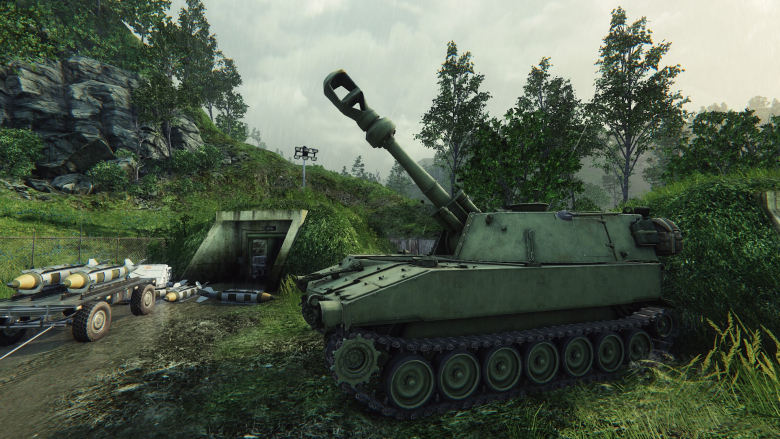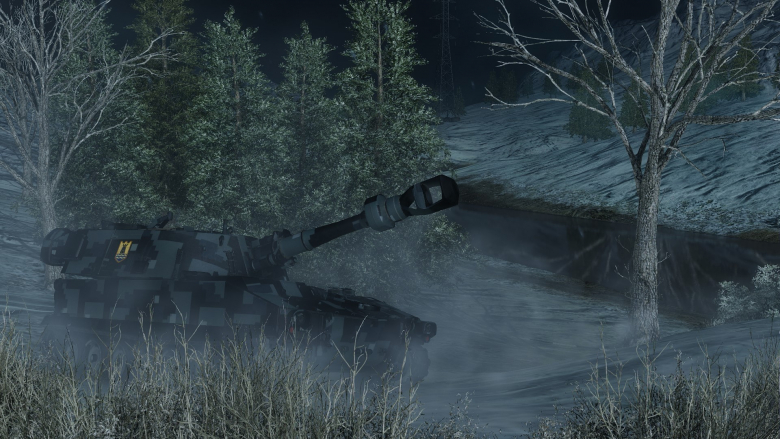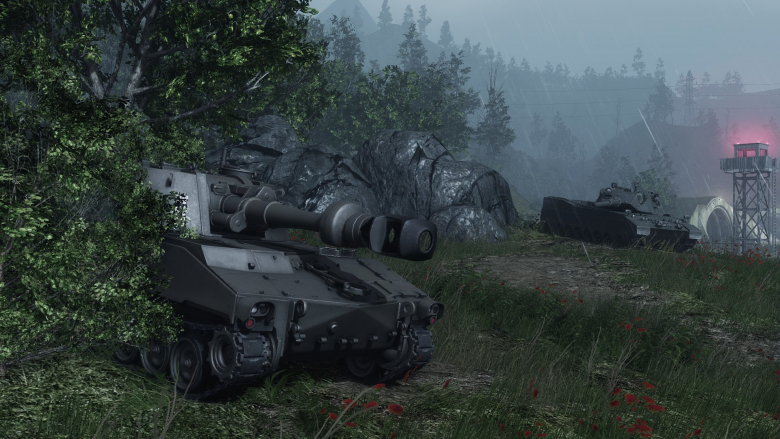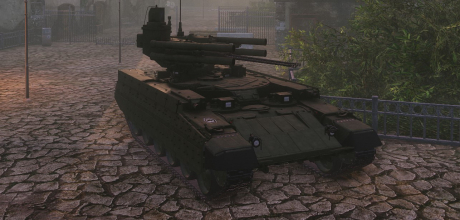
The development history of the M109 155mm self-propelled howitzer, much like the one of its sibling project, the M108, goes back to the days of Second World War and the realization that standard towed artillery was extremely vulnerable.

The early development process was already described in the M108 article – to sum it up, the American military decided that they want two distinctive artillery calibers, the lighter 105mm and the heavier 155mm. The development of the 105mm self-propelled armored gun eventually ended with the M108, which was discontinued relatively early on. The 155mm caliber, however, stayed and the United States Army uses it until this day in the form of a heavily modernized M109.
The M109 development started in April 1953 under the designation of T196. The development of the M108 (T195) and M109 (T196) ran in parallel, both vehicles encountered the same issues early on, including the final drive problems. The T196 was a more sophisticated design than the T195 – it included turret power traverse and hydraulics-operated rear braces (due to the increased recoil of the 155mm howitzer compared to the smaller 105mm gun of the T195), which is why the first prototype was built five months later after the T195 and was first tested in March 1959 at Fort Knox.
Due to these issues, the entire program was effectively put on hold until they could be solved. At roughly the same time, following the M48 to M60 series upgrade, it was decided that the future self-propelled guns would receive diesel engines. Up until this point, four prototypes of T195 and T196 were built, two of which received the new diesels along with new designations – for the T196 it was T196E1.

The testing of these new variants resumed in 1960 and while both the T195E1 and the T196E1 were still plagued by drivetrain breakdowns, increased attention to engineering quality managed to solve most issues. Another T196E1 prototype was carefully assembled and eventually passed all the tests required. In December 1961, the U.S. Army ordered a limited production run.
The T196E1 was tested for the most of 1962 with the actual production starting late that year under the new military designation: M109, 155mm, Howitzer, Self-Propelled.
The M109 itself carried a crew of six men (the M108 carried 5 – the sixth man was another assistant loader), although technically the crew actually consisted of ten men with four more travelling on the accompanying M548 cargo carrier and helped with the loading process.
The M109 weighed 23.8 tons (the M108 was almost three tons lighter). The armor of both vehicles was the same though – 32mm aluminum plates designed to stop small arms fire and artillery shell fragments, but little else. After all, if such a vehicle came under heavy direct fire, something was terribly wrong indeed.
The vehicle was powered by a 9.3 liter Detroit Diesel 8V71T supercharged V8 diesel engine, producing some 340 net horsepower. This gave the M109 a power-to-weight ratio of 14.3 hp/t and maximum speed of 56 km/h (35 mph) – the same maximum speed as the M108 had, despite the increased weight.

The biggest difference between the M108 and the M109 was, of course, the armament. The M109 was armed with the 155mm M126 or M126A1 howitzer mounted in a fully traversable turret. Unlike in the M108, the M109’s turret traverse mechanism was hydraulic, allowing it to engage different targets faster. The maximum turret traverse rate was 11 degrees per second. The gun could elevate to +75 degrees and depress to -3 degrees. Its maximum range was 14.6km.
The loading system was semi-automatic (compared to the purely manual M108 loading) but the rate of fire was still considerably lower than that of the M108 – it could reach approximately 4 rounds per minute (M108 could reach 10 rounds per minute depending on the skill of the loaders), although it’s worth noting that this rate could only be sustained for approximately three minutes (until the crew ran out of “ready” ammunition), after which it dropped to one round per minute. The vehicle carried 26 rounds of ammunition with more carried by the abovementioned M548 cargo carrier.
Of the pair of SPGs, the M109 became the more successful one with the M108 production halted in 1963 with only 355 pieces built due to the increased European theater divisional artillery firepower requirements that called for the 155mm caliber. The first M109 entered U.S. service in June 1963. The M109 production numbers were as such:
- 2111 vehicles for the U.S. military (150 of which went to the U.S. Marine Corps)
- 1675 vehicles manufactured for export
Bringing the total production to 3786 vehicles between 1962 and 1969. All of these vehicles were built in the Cleveland Tank Plant.
Although the M109 was intended primarily for the forces stationed in Europe, it was first used in combat during the Vietnam War. The Vietnam War was also the only time it was used in combat alongside the M108, which was phased out after the war ended. The most common use of the M109 in the Vietnam War was as a part of U.S. Army firebases – its turret traverse allowed it to rapidly switch targets and to provide the U.S. forces with short response time indirect fire support. The firepower of 155mm shells was especially devastating against infantry, light fortifications and other soft targets. The first M109s appeared in Vietnam in June 19 1966 and there were already as many as 108 M109s stationed there by mid-1968. The last M109 battalion was withdrawn from Vietnam by the end of 1971.

One lesson that the Vietnam War taught the American artillerymen was that range was of paramount importance. The M108s were often outranged by the Soviet 130mm artillery guns and the M109 did not fare much better. One solution to the issue that was tested was using stronger propellant charge, but this process stressed the gun too much, resulting in much shorter life-span of the weapon and potential danger to the crew.
The second solution for existing vehicles was the introduction rocket-assisted ammunition (HERA), which increased the gun range to approximately 19km. This happened eventually in the form of 155mm M549 rounds.
The ultimate solution to the range extension issue was, however, the introduction of longer 155mm cannon that was eventually introduced on the M109 chassis under the designation of M109A1 in 1971. Between 1973 and 1981, all M109s in American service were converted to the M109A1 standard, making the Vietnam War the only conflict the M109 actively participated in in American hands.
Apart from the U.S. military, there were numerous foreign users as well. The biggest was the Bundeswehr with 609 vehicles purchased from 1964 onwards, also becoming the first foreign operator. It’s possible that a number of these vehicles eventually ended in Israel (like it happened with other weaponry such as the Patton tanks) but data about such trades are generally not publicly available.
The second one was Israel with 24 M109s purchased in 1969 – these were successfully used in the Yom Kippur war of 1973, leading to further purchases. The Israeli Defense Force eventually operated 369 M109s of different variants – most of the older M109s were converted to M109A1s.

Iran ordered 50 M109s in the 1970s, all of which were upgraded to the M109A1 standard later on and before the fall of the Shah, it operated 369 M109 series vehicles. Most were destroyed or captured by the Iraqi during the Iran-Iraq war.
Other original M109 users include:
- Austria (38 vehicles)
- Canada (50 vehicles, later upgraded to M109A1/A3)
- Denmark (76 vehicles, later upgraded to M109A1/A3)
- Ethiopia (12 vehicles)
- Italy (221 vehicles without armament, equipped with a locally-produced OTO Melara 155mm gun)
- Jordan (126 vehicles, later upgraded)
- Netherlands (135 vehicles, later upgraded to M109A3, 85 of which were sold to UAE)
- Spain (18 vehicles)
These sales numbers make the M109 one of the most successful self-propelled artillery designs of the cold war. The M109 series is – in an upgraded form – currently still in service in many countries and will likely continue to be in the next two or three decades.
In Armored Warfare, the M109 is currently a Tier 4 SPG class vehicle. In Balance 2.0, it will retain its indirect fire ability, but it will become available in PvE mode only with proper adjustments to performance to ensure its viability. It will become a part of the Zhang Feng combined self-propelled gun branch.
We hope that you will enjoy it in its new form and will see you on the battlefield!








